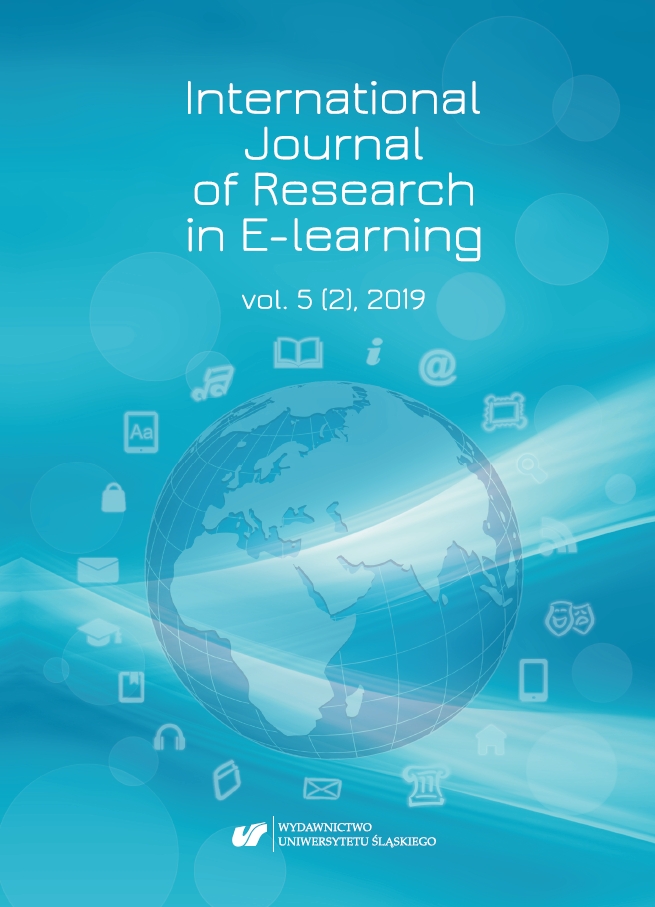Arafeh, S. (Ed.) (2004). The implications of information & communications technologies for distance education: Looking toward the future (Final Report). Retrieved from http://www.sri.com/policy/csted/reports/sandt/it/Distance_Ed_Lit_Review_FINAL_6-9-04.pdf.
Google Scholar
Brenton, S. (2009). E-learning – an introduction. A handbook for teaching and learning in higher education. Taylor&Francis. Retrieved from: https://www.sun.ac.za/english/learning-teaching/ctl/Documents/A%20Handbook%20for%20Teaching%20and%20Learning%20in%20Higher%20Education%20Enhancing%20academic%20and%20Practice.pdf (reference date: 01.02.2019).
Google Scholar
Chongwony, L. K. E. (2008). An investigation of social presence in postsecondary learners enrolled in online learning environment. (Doctoral Dissertation). The College of Education of Ohio University. Retrieved from https://etd.ohiolink.edu/!etd.send_file?accession=ohiou1199472454&disposition=inline (reference date: 01.02.2019).
Google Scholar
Distance Education Models and Best Practices. (2011). Retrieved from https://www.imperial.edu/ivc/files/Distance_Education_Models_and_Best_Practices.pdf (reference date: 06.02.2019).
Google Scholar
Er, E., Özden, M., & Arifoglu, A. (2009). A blended e-learning environment: A model proposition for integration of asynchronous and synchronous e-learning. International Journal Of Learning, 16(2), 449–460.
Google Scholar
Harris, J., Mishra, P., & Koehler, M. (2009). Teachers’ technological pedagogical content knowledge and learning activity types: Curriculum-based technology integration reframed. Journal of Research on Technology in Education, 41(4), 393–416. Retrieved from http://learnonline.canberra.edu.au/file.php/5963/TPACK_UC/pdf/harris_mishra_koehler_jrte.pdf (reference date: 03.01.2019).
Google Scholar
Hrastinski, S. (2008). Asynchronous & synchronous e-learning. EDUCAUSE Quarterly, 31(4), 51–55. Retrieved from http://net.educause.edu/ir/library/pdf/eqm0848.pdf (reference date: 15.02.2019).
Google Scholar
Kearney, M, Schuck, S., Burden, K., & Aubusson, P. (2012). Viewing mobile learning from a pedagogical perspective. Research in learning technology, 20. Retrieved from https://journal.alt.ac.uk/index.php/rlt/article/view/1225/pdf (reference date: 25.01.2019).
Google Scholar
Liu, Y. & Ginther, D. (1999). Cognitive styles & distance education. Online Journal of Distance Learning Administration, 2(3). Retrieved from http://www.westga.edu/~distance/liu23.html (reference date: 25.01.2019).
Google Scholar
Motiwalla, L. F. (2007). Mobile learning: A framework and evaluation. Computers & Education, 49(3), 581–596.
Google Scholar
Prigozhina, K. & Trostina, K. (2016). Modern distant and electronic technologies as triggers of enhanced professional language training opportunities in the system of higher education. Informatization of higher education: current situation and development prospects :materials of the II international scientific conference on October 12–13, 2016. Prague: Vědecko vydavatelskécentrum «Sociosféra-CZ»
Google Scholar
Sad, S. N. & Goktas, O. (2013). Preservice teachers’ perceptions about using mobile phones and laptops in education as mobile learning tools. British Journal of Educational Technology, 45(4), 606–618.
Google Scholar
Schlosser, L. A., Ashland, O., & Simonson, M. (Eds.). (2002) Distance education: Definition & glossary of terms. Bloomington, IN: Association for Educational Communications & Technology (AECT). Retrieved from http://www.nova.edu/~simsmich/pdf/jan%2024.pdf (reference date: 30.01.2019).
Google Scholar
Simonson, M., Smaldino, S., Albright, M., & Zvacek, S. (2012). Teaching and learning at a distance: Foundations of distance education. (5th ed.). Boston: Pearson.
Google Scholar
Smyrnova-Trybulska, E. (2016). Some aspects of increasing the effectiveness and comfort of the scientific and educational process in university electronic environment. A research report. New Educational Review, 45(3), 259–270.
Google Scholar
Towhidi, A. (2010). Distance education technologies and media utilization in higher education. International journal of instructional technology and distance learning, 7, 8, 3–30.
Google Scholar
Unwin, D. & Mc Aleese, R. (1988). The encyclopedia of educational media communications technology. New York: Greenwood Press.
Google Scholar


 https://doi.org/10.31261/IJREL.2019.5.2.01
https://doi.org/10.31261/IJREL.2019.5.2.01
